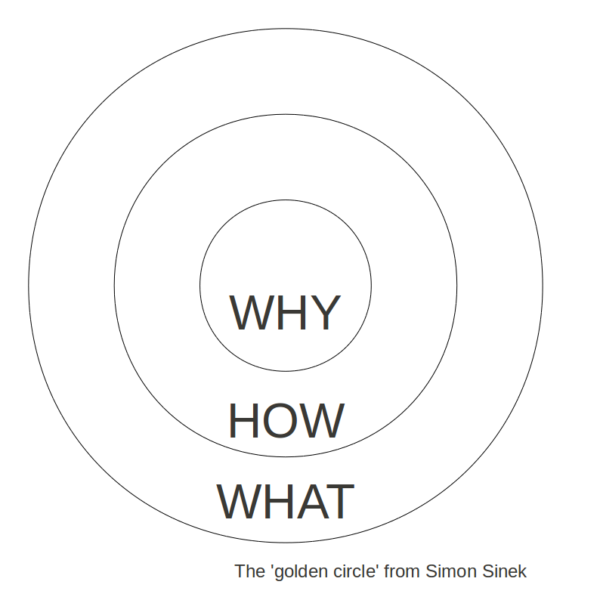The Golden Circle Theory: Find Your Brand’s Why, How, and What
Few businesses today can thrive by simply inundating customers with messages about the features and benefits of their products or services. People need a deeper reason to choose your brand over another. If you’re not sure what that reason is, your business will likely struggle to thrive among all the competition.
The sheer volume of companies seeking to gain and keep a foothold in today’s market means that your business needs something special to get through all the noise, and this is where the Golden Circle theory comes into play.
Originally coined by Simon Sinek, leadership expert and author of the classic “Start With Why,” the Golden Circle theory argues that many of today’s most successful companies think beyond the practical, rational benefits of their products and services. While some companies start by explaining what they offer to their customers, big names like Apple first examine the how and why behind their business.
Just consider Apple’s slogan “Think Different” and how unrecognizable this tech behemoth would be today if it instead settled on “We sell computers.” From Apple’s perspective, customers choose a business based on more nebulous, emotional reasons than simply needing a MacBook or iPhone. In short, people want to support companies driven by shared values and beliefs.
Apple was able to thrive by appealing to customers in a more meaningful way from the start. But why does this tie in with the Golden Circle, and how can companies incorporate it into their marketing plans? Read on to discover the basics of the Golden Circle theory, how it applies to marketing, and what makes it so important for businesses large and small.
What is the Golden Circle theory?
While it may seem like the reasons people choose one company over another are difficult to pin down, the Golden Circle theory suggests otherwise. From a customer’s perspective, it can appear that businesses simply want to make money and that values or the “why” are afterthoughts.
However, companies like Apple approach things in a completely different way by starting with their “why” before mentioning their products and the “how” and “what.” The fundamentals of the Golden Circle theory are relatively straightforward and consist of three main parts.

The “why”
Since, as Sinek says, “People don’t buy what you do, they buy why you do it,” the question of “why are we in this business?” should be the focal point of any brand. Naturally, small business and nonprofit leaders are focused on the bottom line, but there is a valuable story to be told via the reasons why your business or nonprofit does what it does.
Perhaps there’s an unfulfilled need in the marketplace or your community that your business will cover, or maybe you simply have an innovative vision for the future of your industry. Perhaps your business has a personal or mission-driven “why.”
The “why” behind your brand should define the company’s overarching purpose beyond the bottom line, giving customers and employees a more meaningful reason to support your business.
A great example of an established brand explaining its “why” can be seen in Tesla’s mission statement: “Tesla believes the faster the world stops relying on fossil fuels and moves towards a zero-emission future, the better.” This simple sentence summarizes the foundation of Elon Musk’s company, attaching his brand to a nobler endeavour than simply selling electric vehicles or solar panels.
The “how”
The next part of the Golden Circle theory addresses how your brand achieves its “why” objective. This may include the processes or systems that separate your business from competitors. For example, you can create an online clothing store that uses only ethically sourced fabrics to support your “why” of moving fashion in a more sustainable direction.
For Amazon, Jeff Bezos’s stated “why” goal is to “continually raise the bar of the customer experience by using the internet and technology to help consumers find, discover and buy anything.”
How did his company manage to meet this objective and become such a powerhouse in the eCommerce industry? For one thing, Amazon built a robust platform that’s easy to use, bringing thousands of merchants together into a single online marketplace. To ensure expedited deliveries at a lower cost to subscribers, Amazon also created its fleet of vehicles and established micro-fulfilment centres across the United States.
The “what”
The final aspect of a Golden Circle brand is what your company actually does regarding its products or services. This portion of the Golden Circle theory should position your company in the market as a distinctly unique and innovative industry leader.
While this part of the Golden Circle seems self-explanatory, it’s important to consider how your offerings correspond to the why and how that defines your brand. What is it about your products or services that bolster the purpose of your company? For a company like Tesla, selling electric vehicles is simply a means to achieve its stated goal of making the world less dependent on fossil fuels.
Regardless of “what” you are selling, your products or services must relate to the company’s primary vision and motivation. If you keep the “why” squarely in mind, compelling brand messaging will follow.




